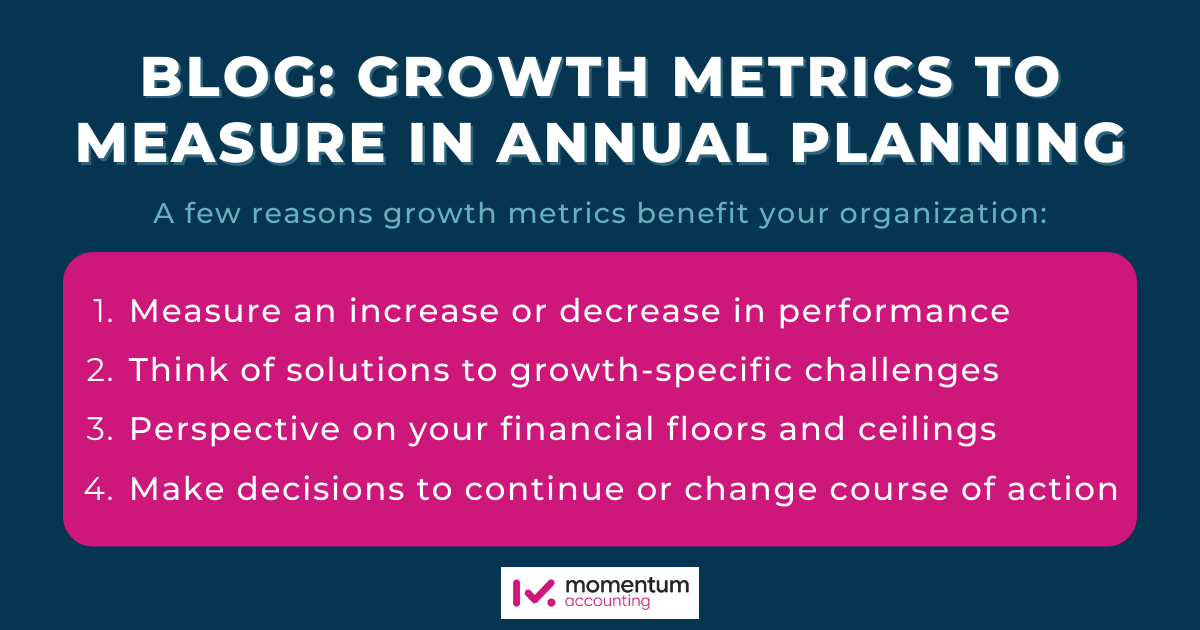Your annual plan is your company’s “North Star” for the following year. Its core function is to provide every decision-maker with an actionable framework to make decisions.
The challenge many organizations face comes in the way of deciding what KPIs to measure.
There are dozens of different ways to measure progress — from budgets to granular sales metrics (like prospecting and outreach). But if you want to make sure that your organization is moving forward, then growth metrics need to be an integral part of your annual plan.
This article will give you a brief primer on what metrics to include if growth is your focus for the following year.

Why Focus On Growth Metrics?
Many KPIs can help you identify how efficiently you operate or can help you get an idea of your financial health. Growth metrics focus on how you are moving your business forward.
Growth can mean different things for different businesses. This is why you can find growth metrics across several different areas. The main idea is that you can pick and choose the metrics that are the most meaningful and make the biggest financial impact.
Here are a few reasons growth metrics benefit your organization.
1. Measure an increase or decrease in performance
Growth metrics can be significant indicators of your overall performance. If your business is in a growth cycle, then these metrics give you clear insight into how many of your goals you are reaching. Also, they will reflect the effectiveness of any strategic decision you make.
2. Think of solutions to growth-specific challenges
New solutions for your business challenges are often necessary. You may have already tried your go-to ways of making things work. But if you are trying something entirely new to spur growth, these metrics will give you instant feedback.
3. Perspective on your financial floors and ceilings
One of the best reasons to include growth metrics in your annual plan is that it lets you see how they impact your business as a whole, especially in terms of financial records. This additional context can be a valuable resource whenever you are evaluating whether a strategic action is giving you the results you expected.
4. Make decisions to continue or change course of action
The risk that every business takes on when they pursue growth is that it may not work. In other words, you may not see the ROI you expected from your investment in growth. Having meaningful growth metrics in place can help you make the decision to continue your investment in growth or cut your losses.
3 Growth Areas to Consider
As stated previously, growth is case-by-case dependent. Because of that, here are a few different areas where you can focus your growth efforts that will definitely translate to your bottom line.
1. Sales and new client acquisition
For most businesses, nothing happens until you make a sale. Having sales-focused growth metrics can give you valuable insight into how your revenue will be impacted. So if your business is sales driven, it makes sense to include sales metrics as part of your growth dashboard.
Here are a few metrics to consider:
- Sales conversion rate
- Average deal size
- Churn Rate
2. Marketing growth
Marketing can have a massive impact on your overall growth. Any improvement in your marketing metrics can have a direct impact on your sales. Marketing is a prime area to keep track of. Typically, marketing growth metrics are more valuable in businesses that have a short sales process or if it is highly automated.
Marketing metrics to consider:
- Customer Acquisition Cost
- Customer Lifetime Value
- Conversion Rate
3. Human Resources
Your human resource department is the literal heart of your operation. Without the right people in place, your business will have a hard time growing. It’s for this reason that the human resource aspect of growth needs to be included in every growth-centric annual plan. Here are a few HR-driven metrics for reference:
- Total cost of the workforce
- Employee Headcount
- Time to hire

Integrating Growth Metrics into Your Annual Plan
Traditionally, annual plans stick to defining financial and operational goals. And if this is what your organization typically does, it may take some work to include new metrics in your dashboard.
However, if growth is high on your priority list, then it only makes sense to include them in your annual planning sessions. The good news is that it can be very simple to see a cause-and-effect relationship between your growth metrics and your other financial KPIs.
Due to external factors such as the global economy or hiring challenges, growth may or may not be a top priority. But focusing on efficiency and a solid financial foundation are always high on the priority list for top performers.
If you need a partner to help make the connection between your bottom line and the metrics you track, we’d love to help. Find out more here.


